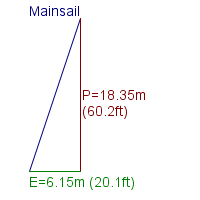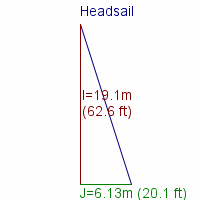Review of Hanse 508
Basic specs.

If you have a photo you would like to share: Upload Image
Looking for a new boat? Find a Hanse 508 or similar boat for sale
The hull is made of fibreglass. Generally, a hull made of fibreglass requires only a minimum of maintenance during the sailing season.
The boat is equipped with 630.0 liter fresh water capacity.
The Hanse 508 is equipped with a fractional rig. A fractional rig has smaller headsails which make tacking easier, which is an advantage for cruisers and racers, of course. The downside is that having the wind from behind often requires a gennaker or a spinnaker for optimal speed.
The Hanse 508 has been built with different keel alternatives.
L-shape fin keel
One option is a L keel. An L-shape keel is a bulb keel with the shape as an L. This keel is less exposed to seaweed, fishing nets and lines.
The boat can only enter major marinas as the draft is about 2.40 - 2.50 meter (7.87 - 8.17 ft) dependent on the load. See immersion rate below.
L-shape fin keel
Another option is a L keel. An L-shape keel is a bulb keel with the shape as an L. This keel is less exposed to seaweed, fishing nets and lines.
Hanse 508 can only enter major marinas as the draft is about 1.98 - 2.08 meter (6.50 - 6.80 ft) dependent on the load. See immersion rate below.
The Hanse 508 has been equipped with different engine alternatives.
Alternative 1:
The boat may be equipped with an inboard diesel engine at 80 hp (59 kW).
The transmission is a saildrive.
Alternative 2:
The boat may be equipped with an inboard diesel engine at 75 hp (55 kW).
The transmission is a saildrive.
Note: Optional engine.
The fuel tank has a capacity of 280.0 liters (73 US gallons, 61 imperial gallons).
Sailing characteristics
This section covers widely used rules of thumb to describe the sailing characteristics. Please note that even though the calculations are correct, the interpretation of the results might not be valid for extreme boats.
Hanse 508 holds a CE certification:
If less than 12 in on board the boat is by European Union certified as Class A. OCEAN:What is Theoretical Maximum Hull Speed?
The theoretical maximal speed of a displacement boat of this length is 8.9 knots. The term "Theoretical Maximum Hull Speed" is widely used even though a boat can sail faster. The term shall be interpreted as above the theoretical speed a great additional power is necessary for a small gain in speed.
The immersion rate is defined as the weight required to sink the boat a certain level.
The immersion rate for Hanse 508 is about 430 kg/cm, alternatively 2412 lbs/inch.
Meaning: if you load 430 kg cargo on the boat then it will sink 1 cm.
Alternatively, if you load 2412 lbs cargo on the boat it will sink 1 inch.
Sailing statistics
This section is statistical comparison with similar boats of the same category. The basis of the following statistical computations is our unique database with more than 26,000 different boat types and 350,000 data points.
What is L/B (Length Beam Ratio)?
The l/b ratio for Hanse 508 is 3.14.
The ballast ratio for Hanse 508 is 28%.
Maintenance
When buying anti-fouling bottom paint, it's nice to know how much to buy.
The surface of the wet bottom is about 73m2 (785 ft2).
Based on this, your favourite maritime shop can tell you the quantity you need.
Note: If you use a paint roller you will need more paint than if you use a paintbrush.
Dimensions of sail for fractional rig.


Are your sails worn out? You might find your next sail here: Sails for Sale
If you need to renew parts of your running rig and is not quite sure of the dimensions, you may find the estimates computed below useful.
| Usage | Length | Diameter | ||
| Mainsail halyard | 47.2 m | (154.8 feet) | 14 mm | (0.55 inch) |
| Jib/genoa halyard | 47.2 m | (154.8 feet) | 14 mm | (0.55 inch) |
| Spinnaker halyard | 47.2 m | (154.8 feet) | 14 mm | (0.55 inch) |
| Jib sheet | 14.9 m | (49.0 feet) | 16 mm | (5/8 inch) |
| Genoa sheet | 14.9 m | (49.0 feet) | 16 mm | (5/8 inch) |
| Mainsheet | 37.3 m | (122.5 feet) | 16 mm | (5/8 inch) |
| Spinnaker sheet | 32.8 m | (107.8 feet) | 16 mm | (5/8 inch) |
| Cunningham | 6.2 m | (20.2 feet) | 14 mm | (0.55 inch) |
| Kickingstrap | 12.3 m | (40.4 feet) | 14 mm | (0.55 inch) |
| Clew-outhaul | 12.3 m | (40.4 feet) | 14 mm | (0.55 inch) |
This section is reserved boat owner's modifications, improvements, etc. Here you might find (or contribute with) inspiration for your boat.
Do you have changes/improvements you would like to share? Upload a photo and describe what you have done.
We are always looking for new photos. If you can contribute with photos for Hanse 508 it would be a great help.
If you have any comments to the review, improvement suggestions, or the like, feel free to contact us. Criticism helps us to improve.
